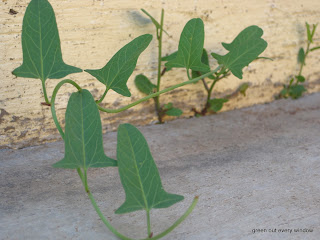 |
| By Bel Mills |
Yep. It was a weed. Growing into our bedroom. Suffice it to say, this was the moment I realized we had a spectacular weed problem at our new house.
This current weed, on the other hand, is an actual thug of the weed world. A professional. Master gardeners call it a perennial weed because it returns from the roots every year, whether it drops seed or not. Known as Convolvulus arvensis, or field bindweed, it grows in all 50 states, and considered noxious in 20—though not here in Nevada. My Rodale’s guide to weeds gives a stern warning to “not let it remain in the garden long enough to gain a foothold…because the roots are extensive and can grow 10 feet below the soil surface.”
So much for not giving it a foothold. By the time we moved in, it was practically the only plant thriving in the neglected yard, happily winding itself amongst half-dead roses in the front, and sprawling along the foundation in the back. I remember being charmed by its pale, morning glory-like blooms.
 |
| Courtesy of Wikipedia |
With more than a twinge of regret, I methodically ripped it out. I knew nothing about different types of weeds at the time, and I thought once we pulled it—and installed new pavers, turf, and planting beds-- we’d be rid of it. I certainly didn’t know the roots, which snapped when tugged, would spawn new plants from every fragment left behind.
In no time, we found shoots growing through our new pavers,
 |
| By Bel Mills |
into our new grass,
 |
| By Bel Mills |
and filling our new planting beds.
 |
| By Bel Mills |
Eventually it even emerged between the foundation of the house and the concrete in the side yard.
 |
| By Bel Mills |
Then, spectacularly, it moved into the bedroom. At that point, we knew more investigation was required. Removing the air register in our bedroom, I saw the plant had grown into the house from the crawl space by wedging its way between the edge of the metal air duct and the subfloor. When I pulled the duct aside, I saw the remains of the shoot—which I’d impulsively yanked on sight: several telltale winding brown stems.
 |
| By Bel Mills |
They look thoroughly dead, and yet they’d managed to produce one very alive shoot.
At this point my husband put on his brave pants and ventured under our house with a garbage bag to do battle, the chorus from Little Shop of Horrors no doubt ringing in his ears. He made his way through the cramped crawl space, to the ground underneath our bedroom. He emerged about fifteen minutes later…
 |
| By Bel Mills |
…with his bag full of this:
 |
| By Bel Mills |
After that, we were certain we’d eliminated the section of weed growing into, or through, the house. But this spring, we found another shoot between the wooden trim of an exterior door and the stucco of the house.
 |
| By Bel Mills |
What happened to that one, you ask? Officially, it’s known as acute glyphosate damage. In other words, my husband sprayed the heck out of it with Roundup. The chemical route was a no-brainer in cases where the weed was growing through construction material. But when my husband eyed the lawn, I balked. Not wanting to disturb the precious circle of life I’d read about in Teaming with Microbes: the organic gardener’s guide to the soil food web, I insisted on just pulling it out. And pulling it again. And then pulling some more.
You can imagine how happy I was to learn, during master gardener training this year, that Round Up breaks down readily in the soil, as does 2,4-D (which will kill the weed in your lawn without killing the lawn.) I also learned it can take up to five years of consistent pulling to successfully eradicate a perennial weed.
No thank you.
Since then, my husband and I have unleashed round after round of chemical fury. We use Roundup where no other plants are present, and a product containing 2,4-D, which won't kill grasses, in the lawn. We are making progress, though some patches are proving remarkably resistant.
 |
| By Bel Mills |
We will prevail! Um, I think. Wish us luck.